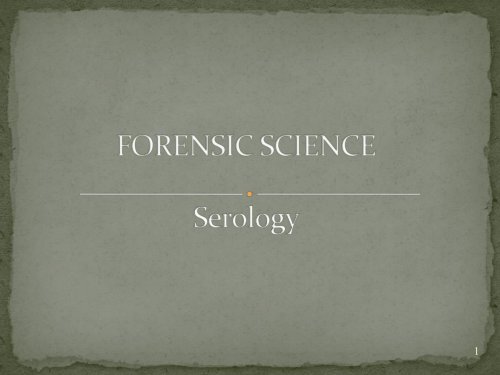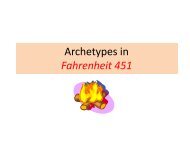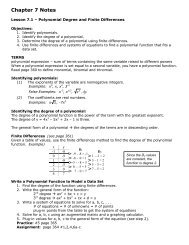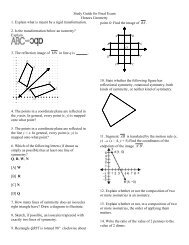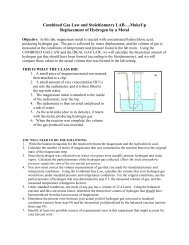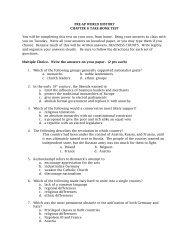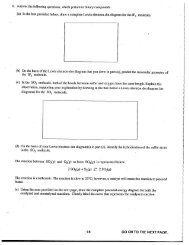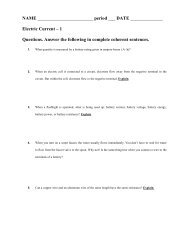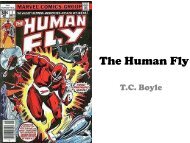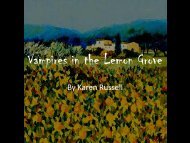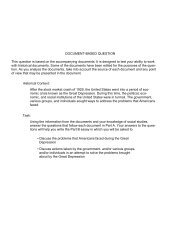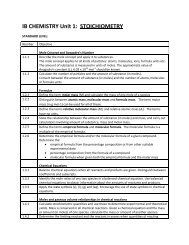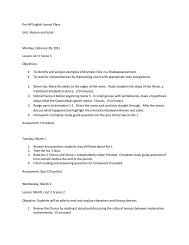Serology ppt
Serology ppt
Serology ppt
Create successful ePaper yourself
Turn your PDF publications into a flip-book with our unique Google optimized e-Paper software.
• Plasma--fluid portion of the blood (55%)<br />
• Serum--liquid that separates from the blood when a<br />
clot is formed<br />
2
• Cells (45%)<br />
• Erythrocytes--red blood cells; responsible for oxygen<br />
distribution<br />
• Leukocytes--white blood cells; responsible for “cleaning”<br />
the system of foreign invaders<br />
• Thrombocytes--platelets; responsible for blood clotting<br />
3
• ABO blood groups--based on having an A, B, both<br />
or none of the factors on the red blood cell<br />
• Rh factor--may be present on the red blood cell;<br />
positive if present and negative if not<br />
4
•Antigen--a substance found on a red blood cell<br />
•Antibody--a substance that reacts with an antigen<br />
•Agglutination--clumping of red blood cells; will result if<br />
blood types with different antigens are mixed<br />
5
Blood is a slightly alkaline fluid<br />
made up of :<br />
water<br />
cells<br />
enzymes<br />
proteins<br />
and inorganic substances<br />
that circulate throughout the vascular<br />
system carrying nourishment and<br />
transporting oxygen and waste.<br />
6
• The most non-fluid portion of<br />
blood consists of red cells which<br />
outnumber . white cells by five<br />
hundred to one.<br />
• While medical scientists are more<br />
interested in white cells, forensic<br />
scientists are more interested in<br />
red cells and secondly with serum.<br />
7
With serum, the analyst can determine<br />
the freshness of a blood sample because<br />
serum clots several minutes after<br />
exposure to air (a centrifuge is<br />
necessary to separate clotted material<br />
from the rest of serum).<br />
In serum are also found antibodies,<br />
which have important forensic<br />
implications.<br />
8
• The typing of blood, with what is now called the<br />
A-B-O system, was discovered in 1901.<br />
• A few years later, starting around 1937, a series of<br />
antigen-antibody reactions were discovered in<br />
blood, the most common ones being ABH, MN,<br />
Rh, and Gm (over 100 antigens exist).<br />
• Most people are only familiar with the Rh factor,<br />
which is technically the D antigen. There are more<br />
than 256 antigens, and 23 blood group systems<br />
based on association with these antigens.<br />
9
O A B AB<br />
43-45% 40-42% 10-12% 3-5%<br />
O+ 39%<br />
O- 6%<br />
A+ 35%<br />
A- 5%<br />
B+ 8%<br />
B- 2%<br />
AB+ 4%<br />
AB- 1%<br />
10
1901. Karl landsteiner<br />
• First to identify A-B-O human blood groups<br />
• Nobel prize in 1930 for work<br />
• 1937. Identified Rh factor (+ or -)<br />
Right: Dr. Karl Landsteiner<br />
11
Around 1900, Karl Landsteiner discovered that there<br />
are four different kinds of human blood based on<br />
the presence or absence of specific antigens found<br />
on the surface of the red blood cells.<br />
In 1940 Landsteiner and Weiner reported the<br />
discovery of the Rh factor by studying the blood of<br />
the Rhesus monkey. 85% of Caucasians, 94% of<br />
Black Americans and 99% of all Asians are Rh<br />
positive.<br />
12
Questions to be answered:<br />
• Is it blood?<br />
• Is it human blood?<br />
• Whose is it?<br />
• Determine blood type, alcohol content, drugs<br />
present<br />
• Determine the method(s) in which blood may have<br />
been deposited<br />
13
Presumptive Test for blood<br />
1. Kastle-meyer color test<br />
• Phenolphthalein reacts with<br />
hemoglobin<br />
• Turns pink in presence of blood<br />
• Potato and horseradish also turn pink<br />
What is hemoglobin?<br />
a. Protein<br />
b. transports oxygen in blood stream<br />
c. Responsible for the red coloring of<br />
blood<br />
14
• Luminol test--reaction with blood results in the<br />
production of light<br />
15
• Reacts with blood to<br />
produce faint blue glow<br />
• Works even better on<br />
old stains<br />
• Can reveal blood stains<br />
diluted by a factor of 10,000<br />
• Drawback: destroys the<br />
properties of blood<br />
Right: blood normally invisible glows<br />
blue in the presence of luminol<br />
16
• Microscopic survey<br />
• Precipitin test--blood is injected into a rabbit; antibodies<br />
are formed; rabbit’s blood is extracted as an antiserum; the<br />
antiserum is placed on sample blood. It will react with<br />
human proteins. This test is very sensitive and requires<br />
only a small amount of blood.<br />
• Characteristic Differences<br />
17
• Will turn green in the presence of blood and then darken<br />
3. Takayama and teichmann test<br />
• Crystals form when chemicals react with hemoglobin<br />
18
Frog Blood<br />
• Larger nucleic red<br />
blood cells<br />
19
• Numerous non-nucleic<br />
red blood cells--5 to 6<br />
million per mm3<br />
• Larger but less numerous<br />
white blood cells 5 to<br />
10,000 per mm3<br />
• Tiny, cellular fragments<br />
350 to 500,00 per mm3<br />
called platelets<br />
20
• A blood type has antigen A and will agglutinate<br />
with B.<br />
• B blood type has antigen B and will agglutinate<br />
with A.<br />
• AB blood type has antigen A and B and will not<br />
agglutinate with either A or B.<br />
• O blood type has neither antigen A or B and<br />
will agglutinate with either.<br />
21
Type Antigen Antibody Can Give<br />
Blood To:<br />
A<br />
A<br />
B<br />
Can Get<br />
Blood From<br />
A, AB O, A<br />
B<br />
B<br />
A<br />
B, AB O , B<br />
AB<br />
A and B<br />
Neither<br />
A nor B<br />
AB<br />
A, B, O, AB<br />
O<br />
Neither<br />
A nor B<br />
A and B<br />
A, B, O, AB<br />
O
REACTION<br />
Anti-A Serum<br />
Agglutination<br />
No agglutination<br />
Agglutination<br />
No agglutination<br />
Anti-B Serum<br />
No agglutination<br />
Agglutination<br />
Agglutination<br />
No agglutination<br />
BLOOD TYPE<br />
Type A<br />
Type B<br />
Type AB<br />
Type O<br />
23
A. Type AB can give rise to a O offspring<br />
B. Type O can give blood to O only<br />
C. Type AB can give blood to anyone<br />
D. Type AB negative is the rarest in the US<br />
24
A. Type AB can give rise to a O offspring<br />
B. Type O can give blood to O only<br />
C. Type AB can give blood to anyone<br />
D. Type AB negative is the rarest in the US<br />
25
Type<br />
O<br />
A<br />
B<br />
AB<br />
Percent<br />
45<br />
39<br />
12<br />
4<br />
26
Absorption-elution technique<br />
• Antiserum is placed on the blood stain. Antibodies<br />
combine with the specific antigens.<br />
• Unreacted serum is washed off the bloodstain.<br />
• Stained material is heated to 56 degrees C, breaking<br />
the antibody-antigen bond. This process is known as<br />
elution.<br />
• Known red blood cells are added. Agglutination will<br />
occur if antigens present on the added RBC’s were<br />
also originally on the stained material.<br />
27
Enzymes--proteins that speed up or slow down<br />
chemical reactions. Enzymes that exist in different<br />
forms are called polymorphic and can be broken<br />
down into their separate proteins called isoenzymes.<br />
28
• Adenosine deaminase AD<br />
• Adenylate kinase AK<br />
• Carbonic anhydrase II CA II<br />
• Erythrocyte acid phosphatase EAP<br />
• Esterase D EsD<br />
• Glucose-6-Phosphate dehydrogenase<br />
G6PD<br />
• Glyoxylase U GLO I<br />
• Group-specific component Ge<br />
• Haptoglobin Hp<br />
• Peptidase A Pep A<br />
• Phosphoglucomutase PGM<br />
• 6-Phosphogluconate dehydrogenase<br />
6PGD<br />
• Transferrin Tf<br />
29
PGM--phenotypes<br />
Electrophoresis can separate the protein<br />
components into these 10 iso-enzymes.<br />
-<br />
+<br />
1- 1+ 2- 2+ 2-1- 2+1- 2-1+ 2+1+ 2+2- 1+1-<br />
Three of these are most common PGM 1+, PGM 2-1+ and PGM 2<br />
30
EAP--phenotypes<br />
Determined by the intensity of the fluorescence. The<br />
darker the band the more it fluoresced.<br />
B<br />
C<br />
A<br />
A BA B CB C CA<br />
31
SCENE PATTERN<br />
RECONSTRUCTION<br />
1. Stain condition<br />
2. Pattern<br />
3. Distribution<br />
4. Location<br />
5. Directionality<br />
LAB RESULTS<br />
RECONSTRUCTION<br />
1. Genetic marker typing<br />
2. Age Determination<br />
3. Source<br />
Determination<br />
4. Race Determination<br />
5. Sex Determination<br />
From “Cracking Cases” by Dr. Henry C. Lee<br />
32
A field of forensic study which deals with the physical<br />
properties of blood and and the patterns produced<br />
under different conditions as a result of various<br />
forces being applied to the blood. Blood, as a fluid,<br />
follows the laws of physics. It is not influenced nor<br />
affected by race, gender, or age of the one bleeding.<br />
33
• A blood droplet will remain spherical in space until<br />
it drops onto a surface<br />
• Once a blood droplet impacts a surface, a<br />
bloodstain is formed.<br />
• A droplet falling from the same height, hitting the<br />
same surface at the same angle, will produce a stain<br />
with the same basic shape.<br />
34
• Is approximately 0.05 cc<br />
• Is not the same for all blood droplets--from 0.03 cc<br />
to 0.15 cc<br />
• Is directly dependent upon the surface or orifice<br />
from which it originates<br />
• The impact area is called the target.<br />
35
• Size of the droplet<br />
• Angle of impact<br />
• Velocity at which the blood droplet left the<br />
original surface<br />
• Texture of the target surface<br />
• On clean glass or plastic--droplet will have smooth outside<br />
edges<br />
• On a rough surface--will produce scalloping on the edges<br />
36
• The distance between the target surface and the<br />
origin of blood at the time of blood shed<br />
• The point(s) of origin of the blood<br />
• Movement and direction of a person or an<br />
object<br />
• The number of blows, shots, etc. causing the<br />
bloodshed and/or the dispersal of blood.<br />
37
• Type and direction of impact that produced the<br />
bloodshed<br />
• The position of the victim and/or object during<br />
bloodshed<br />
• Movement of the victim and/or object after<br />
bloodshed<br />
38
• Angle of impact--angle at which blood strikes a target<br />
surface.<br />
• Bloodstain transfer--When a bloody object comes into<br />
contact with a surface and leaves a patterned blood<br />
image on the surface.<br />
• Backspatter--blood that is directed back toward its<br />
source of energy.<br />
• Cast-off--blood that is thrown from an object in<br />
motion<br />
39
• Contact stain--general term referring to bloodstains<br />
caused by contact between a wet, blood-bearing surface<br />
and a second surface which may or may not have blood on<br />
it<br />
• Transfer--image is recognizable and may be identifiable<br />
with a particular object<br />
40
• Swipe--wet blood is transferred to a surface which<br />
did not first have blood on it<br />
• Wipe--a non-blood bearing object moves through a<br />
wet bloodstain, altering the appearance of the<br />
original stain<br />
41
• Directionality--relates to the direction a drop of blood<br />
traveled in space from its point of origin<br />
• Terminal velocity--the greatest speed to which a free<br />
falling drop of blood can accelerate in air. It is<br />
dependent upon the acceleration of gravity and the<br />
friction of the air against the blood--approximately 25:1<br />
feet/second.<br />
42
• High velocity--greater than 100 feet per second; gives<br />
a fine mist appearance<br />
• Low velocity--5 feet per second or less<br />
• Medium velocity--5 to 25 feet per second.<br />
43
• Terminal Velocity<br />
• Directionality<br />
• Angle of Impact<br />
44
The shape of a blood stain:<br />
• Round--if it falls straight down at a 90 degree angle.<br />
• Elliptical--Blood droplet elongates as the angle<br />
decreases from 90 to 0 degrees. The angle can be<br />
determined by the following formula:<br />
width = sine of the impact angle<br />
length<br />
45
• The more acute the angle of impact, the more<br />
elongated the stain.<br />
• 90 degree angles are perfectly round with 80 degree<br />
angles taking on a more elliptical shape.<br />
46
• At about 30 degrees the stain will begin to produce a<br />
tail.<br />
• The more acute the angle, the easier it is to determine<br />
the direction of travel.<br />
47
• The harder and less porous the<br />
surface, the less the blood drop<br />
will break apart.<br />
• The softer and more porous the<br />
surface, the more a blood drop<br />
will break apart.<br />
• The pointed end of the blood<br />
stain faces the direction the<br />
stain is traveling.<br />
48
The location of the blood<br />
source can be<br />
determined by drawing<br />
lines the various blood<br />
droplets to the point<br />
where they intersect.<br />
This is the blood’s<br />
origin.<br />
49
The area of<br />
convergence is the<br />
point of origin; the<br />
spot where the “blow”<br />
occurred.<br />
It is determined by<br />
drawing a line from the<br />
area of intersection<br />
straight up to where to<br />
where the angle of<br />
impact would intersect<br />
50
What evidence<br />
can you see in<br />
this crime<br />
scene? What<br />
story does the<br />
scene tell?<br />
51
The dog locates<br />
human scent. A<br />
closer look<br />
shows that the<br />
ashes have<br />
human remains<br />
and clothing.<br />
In addition,<br />
look closely at<br />
the rocks on the<br />
next slide.<br />
52
• Class evidence for blood would include blood<br />
type. If you can determine the DNA you would<br />
have individual evidence.<br />
• Blood stain patterns are considered<br />
circumstantial evidence in a court room.<br />
Experts could argue many points including<br />
direction of stains, height of the perpetrator,<br />
position of the victim, left/right hand, whether<br />
the body was moved, etc.<br />
54
• Among the smallest and most<br />
highly specialized cells in the<br />
human body.<br />
• Has a head and a tail<br />
• Contains 23 chromosomes with<br />
the genetic material found in<br />
the head<br />
• Males release 2.5 to 6 milliliters<br />
of seminal fluid per ejaculation<br />
with approximately 100 million<br />
sperm per milliliter.<br />
Magnified 400X<br />
55
Determination of Seminal Fluid<br />
• Acid phosphatase color test<br />
• the presence of acid phosphatase, the enzyme<br />
secreted by the prostate gland into the seminal fluid,<br />
will turn purple when sodium alpha<br />
naphthylphosphate and Fast Blue B solution are<br />
placed on it.<br />
• It will also fluoresce under UV light when it comes<br />
in contact with 4-methyl umbelliferyl phosphate.<br />
56
Determination of Seminal Fluid<br />
• Prostate Specific Antigen (PSA) or p30--unique<br />
to seminal plasma<br />
• P30 is isolated and injected into a rabbit where<br />
antibodies are produced (anti-p30)<br />
• The stain extract is place in one well of an<br />
electrophoresis plate and the anti-p30 in the<br />
opposite well. The electric is applied and the<br />
antigens and antibodies move toward each other.<br />
The formation of a precipitation line between the<br />
wells shows the presence of p30 in the sample stain.<br />
It must be seminal fluid.<br />
57
• 80% of people are considered secretors. Their<br />
blood-type antigens are found in high<br />
concentration in their body fluids such as<br />
saliva, semen, vaginal secretions and gastric<br />
juice. If you are a secretor, you will have a<br />
higher concentration of A and B antigens than<br />
does your blood!!<br />
• With the advent of DNA, the secretor evidence<br />
is not as important as it once was.<br />
58
• Genotype--letters that represent the traits; ie, AA,<br />
AO, BO, BB, AB and OO<br />
• Phenotype--words that describe the traits<br />
• Heterozygous--different alleles for the same trait;<br />
ie: AO, BO, AB<br />
• Homozygous--the same alleles for the trait; ie: AA,<br />
BB, OO<br />
59


